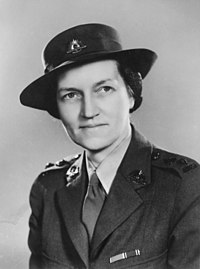Sybil Irving
| Sybil Irving | |
|---|---|

Sybil Irving in 1942
|
|
| Born |
25 February 1897 Victoria Barracks, Melbourne |
| Died | 28 March 1973 (aged 76) South Yarra, Melbourne |
| Allegiance | Australia |
| Service/branch | Australian Women's Army Service |
| Years of service | 1941–46 |
| Rank | Colonel |
| Commands held | |
| Battles/wars | World War II |
| Awards | Member of the Order of the British Empire |
| Relations | Godfrey Irving (father) |
| Other work |
|
Sybil Howy Irving, MBE (25 February 1897 – 28 March 1973) was the founder and controller of the Australian Women's Army Service during World War II. She served in this position from 1941 to 1946 and was active in charity and social organisations until she was aged 74.
Irving was born on 25 February 1897 at Victoria Barracks in Melbourne. She was the oldest of three children and her father, Godfrey Irving, was an Army officer who later held senior positions in the Australian Army. The family moved frequently as her father was posted to new positions, and she was educated at schools in most states.
Irving worked in several social welfare positions after leaving school. During World War I she served in a Red Cross voluntary aid detachment in Australia. In 1924 she became secretary of the Girl Guides' Association, Victoria, a position she held until 1940. In 1935, she was one of the two founders of the Victorian Society for Crippled Children (and Adults) and worked for this organisation until her death. She was appointed a Member of the Order of the British Empire (MBE) on 2 January 1939 for her services to social welfare services in Victoria. Irving left the Girl Guides Association in 1940 to work as Assistant-Secretary of the Victorian Red Cross Society.
In September 1941, Irving accepted an offer from the Army's Adjutant-General, Major General Victor Stantke, to lead the newly formed Australian Women's Army Service (AWAS). This appointment was mainly made on the basis of her family background and guiding experience, and Irving later acknowledged that she had "no qualifications at all" for the position. She was appointed Controller of the AWAS in October and immediately traveled around Australia to recruit officers. She was promoted to lieutenant colonel in January 1942, and successfully established a framework into which 24,000 female soldiers eventually enlisted.
...
Wikipedia
